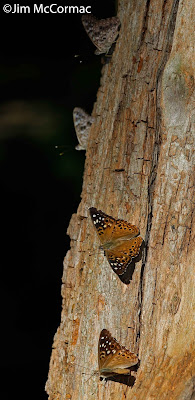A quartet of Hackberry Emperors, Asterocampa celtis, adorn a tree at Kiwanis Park in Columbus. This little-known park is nestled along one of the wilder sections of the Scioto River in this otherwise urban area, and is one of my honey holes when little time is available.
So it was back on August 2, when only a few hours were available to shoot some images. So off to the nearby Kiwanis Park I went, where something of interest can always be found. I had meant to post these pictures long ago, but they got preempted by this, that, and the other. That happens all of the time. Even one good field trip can produce numerous subjects well worth writing about, and things constantly get sent to the end of the line, often never to see the light of day, at least on this blog.
Anyway, I've long had a soft spot for these beautiful butterflies, and admire their pugnacious mannerisms. Chances are good, if a butterfly boldly lands on you, and stays put, or keeps returning, it is a Hackberry Emperor. I have a number of shots of them perched on people's hats, shoulders, noses, whatever.
It's a well-named butterfly, too. The caterpillars eat hackberry foliage. Hence the scientific epithet of the animal's formal name: Asterocampa celtis. Celtis is the genus of hackberry trees. Kiwanis Park has many such trees, and the namesake butterfly isn't hard to find. The Emperor part of the name comes, I suppose, from their habit of regally using people or other animals as their thrones (but I don't know this for sure and feel too lazy to attempt to find out right now).
There is a sister species that is a near look-alike, the Tawny Emperor, Asterocampa clyton. They're around, but at least from my experience, never as commonly as the subject of this post. In fact, that's what I thought these might be at first, as they seemed so bright and buffy - not the colder gray tones that I associate with the Hackberry Emperor. But color varies, and these are bright individuals. A good mark to differentiate the two involves those dots and the bar along the leading edge of the forewing, closest to the body (the black marks, inboard from the white ones). In the Hackberry, the inner bar is broken into two dots. In the Tawny, they congeal into a continuous bar (Hackberry: bar and two dots; Tawny: two bars).
Hackberry Emperors seem prone to perching head down on trees, just as this one is doing. They are easy photographic subjects, often allowing very close approaches. In fact, too close sometimes, as when they land on your camera lens.



No comments:
Post a Comment